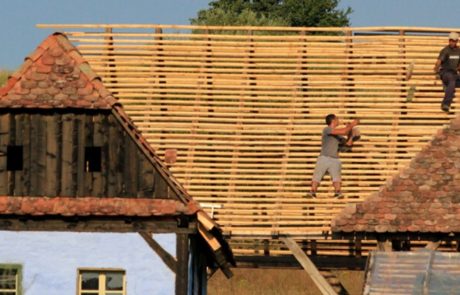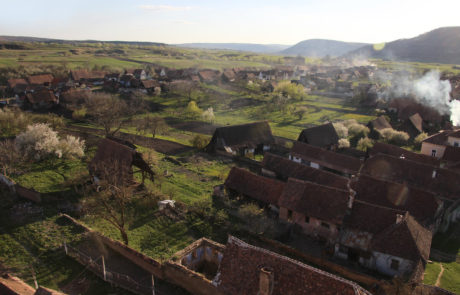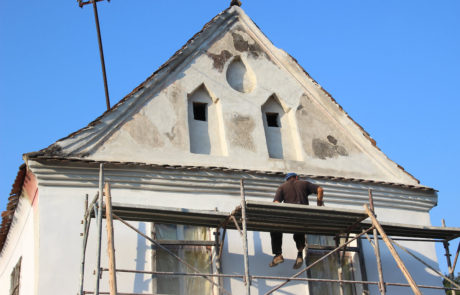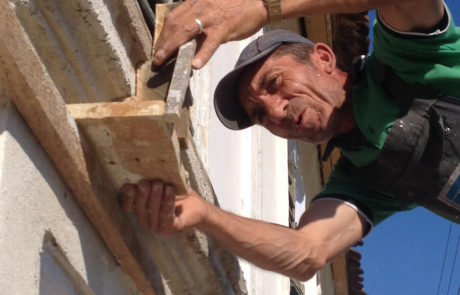Daia, Romania
Reviving artisan traditions to combat rural depopulation and protect Europe’s last medieval landscapes
Among the valley folds and oak forests of Transylvania, the Saxons of 12th century Europe erected villages of walled houses, cobbled courtyards and wooden barns extending in symmetrical strips cleaving to the north side of the Transylvanian Alps.
Each of these Carpathian villages represented the delicate balance between resolute human determination and nature’s inexorable reclamation until centuries of peaceful mountain idyll shattered with the collapse of the Ceausescu regime in the 1990s. Saxon Transylvanians fled to Germany, abandoning their homes and villages. The eminent botanist and conservationist Dr. John Akeroyd has called these nearly deserted remnants surrounded by wildflowers meadows and primary forest, “the very last example of an untouched medieval landscape in Europe.”
Global Heritage Fund and our partners stepped up in 2008 to prevent this vital link to Europe’s past from being lost forever. We identified the village of Daia to serve as our incubator project for the Carpathian Villages conservation area.
Situated around 12 kilometers southwest of the UNESCO World Heritage Site of Schassburg, Daia is particularly well preserved, its 220 houses dating from the 18th and 19th centuries. Displaying German, Romanian, and classical design elements, Daia’s vernacular architecture is a locavore’s delight, built using only lime from local kilns, oak from the surrounding forests, stone from the nearby hills, plus bricks and tiles made by the Roma craftsmen who inhabited the area.
Yet like everywhere across the Transylvanian Alps where thousands of historical structures now stand derelict, most of Daia’s historical structures needed immediate repairs. Global Heritage Fund addressed these urgent prerequisites with our Cultural Emergency Program, through small grants to enable repairs to significant buildings, roofs, and facades.
To ensure Daia’s historically accurate restoration, we began with the building blocks, literally. Handmade terracotta roof tiles that define the region’s distinctive architecture had become difficult to obtain or produce. Local kilns were nearly all shuttered.
Collaborating with the few remaining tile makers, Global Heritage Fund secured investments to build new tile and brick kilns in key villages including Daia. Older generation of tile makers now train young apprentices, re-establishing an industry that will serve the community with new jobs and valuable skills. These kilns also provide employment to laborers, including those transporting and installing the tiles.
Global Heritage Fund’s accomplishments in and around Daia include the identification and classification of the village’s historic, cultural, and agricultural resources, demographic research on past and current residents, and comprehensive cultural mapping. A heritage management plan for Daia incorporates documentation of the history and significant features of Daia, as well as design guidelines, heritage panels to educate locals about their heritage and plans for architectural guidebooks to be used by authorities, architects, and homeowners regarding construction or modification of buildings in the historic preservation area. Our efforts include the implementation of a loan program for homeowners to obtain funds for the authentic preservation of their homes.
Additional resources have been allocated to support Daia’s authentic revival through innovative opportunities in this traditional context. Organic food production and the protection of medieval hay meadows are among the successful measures preserving the environment while encouraging sympathetic economic development within this impoverished region.
Leveraging the past to ensure the future, Global Heritage Fund is strategically developing a tourist infrastructure in Daia, including guesthouses, tour guides, and traditional cuisine restaurants. The true measure of our success with Daia will be other villages across Romania recognizing the transcendent value of their native structures in real economic terms.







